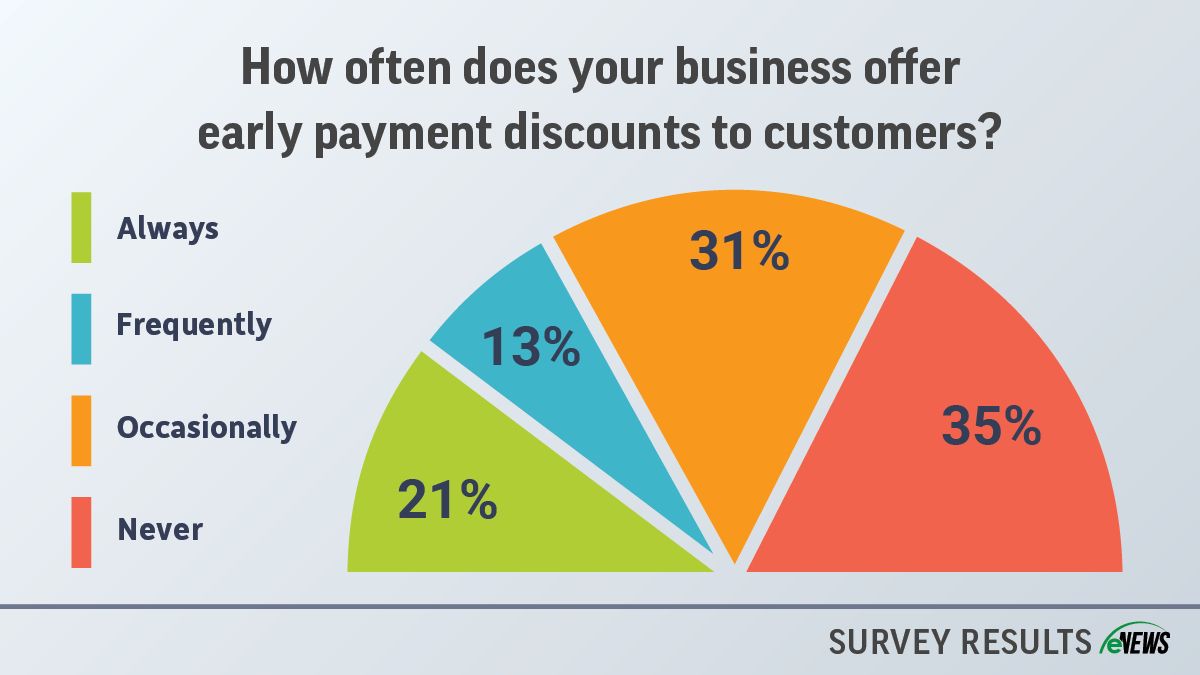Business Practices, eNews
The true cost of early payment discounts

Late payments can be a headache for even the most successful businesses in any industry—putting cash flow, customer relationships and business costs at risk. While most companies use late fees or other penalties to encourage their customers to timely pay, early payment discounts can also be a successful strategy to ensure timely (or early) payments.
Why it matters: Early payment discounts can be a huge incentive for customers to remit payment sooner than the due date, which improves the seller’s cash flow.
Early discounts can be expressed as X/Y Net Z.
- X = percentage discount
- Y = maximum time period to receive the discount
- Z = general credit terms of when the payment is due
For example, 2/10 net 30 would mean the invoice must be paid in 30 days—but the customer could receive a 2% discount on their payment if the invoice is paid within 10 days.
Early payment discounts impact both buyers (customers) and sellers. For customers, it can help their credit history and save overall costs depending on how often the discount is offered. For the seller and the seller’s credit department, early payment discounts will increase cash flow from faster payment and eliminate the payment follow up and collection work. Some companies will also choose to offer early payment discounts to their customers regularly to shorten their cash conversion cycle (CCC) if the business is trying to boost its cash reserves.
What they’re saying: “These discounts improve cash flow because as payments come in quicker, it possibly can reduce the cost of borrowing,” said Janine Sabo, CCE, corporate credit manager at Branscome Operating LLC (Williamsburg, VA). “It entices customers to pay quicker to save money on their end.”
Companies can also include early discounts in their credit policies or terms. Providing the option gives customers better payment flexibility, motivating them to pay their dues. “Typically, payment discounts are offered as a standard for most customers,” said Harry McLaughlin, CCE, CICP, credit operations manager at Continental Tire the Americas (Fort Mill, SC). “There may be different levels of discounts depending on the classification of a customer—whether they’re a large wholesaler or a small dealer, those factors play a role.”
Yes, but: Although offering a discount to receive cash faster may seem attractive from a cash flow perspective, the actual cost of the transaction must be considered.
Discounts are also not a guarantee to on-time payment or payment at all. Early payment discounts can greatly impact pricing. For example, if you offer a customer 1% for payment within 10 days on Net 30 terms, you are giving them a 1% discount to pay you 20 days early, which means it is equivalent to borrowing at 18.25% interest. However, if the customer doesn’t actually pay until day 13 that changes the rate to 21.47%.
Terms offered: 1%10N30
Discounts period: 30 – 10 = 20 days
Number of discount periods per year: 365/20 = 18.25
Discount rate per period: 1% x 18.25 = 18.25%
A lot of companies have discounts automatically built in and customers can look at that as part of their overall pricing. Instead of looking at a discount related to how they pay, they look at the discount related to other pricing, so the customer could feel entitled to it. And in some situations, customers will take the discount and still pay whenever they want, also known as unearned discounts, which creates an additional layer of work to chase down payment.
“From the perspective of a credit manager, there are some disadvantages for sure,” said McLaughlin. “Creditors typically tend to be forced into a situation where they end up waiving any chargeback discounts or taking discounts late. Credit managers across the board are put in a position where you don’t want to be accused of preventing sales. So, the choice is either accept the discount however long it is late, or enforce it and then be put on the carpet to say that you’re costing the company’s sales.”
Despite its benefits and drawbacks, the credit department must look at early payment discounts with a proactive approach. Here are a few tips to follow before offering any discount terms to your customers:
- Do your research to remain within industry standards. “Make sure you are adhering to ethical standards in customers who are offered discount terms,” said Sabo. “Try to also have an internal process in place to handle such things.”
- Create clear guidelines on what is and is not acceptable. For example, do you calculate the discount before the tax total or after? Will you still allow the discount if a customer did not accept it on their payment? Specificity is your biggest ally.
- Plan what and how you will communicate with the customer. “It’s important to notify customers prior to beginning offering the discount,” Sabo said. “We include a notification that discounts taken after the date will not be honored and charged back to the account and include payment methods that are exempt from taking the discount, such as credit card payments.”
The bottom line: Early payment discounts can significantly boost cash flow and encourage timely payments, but businesses should carefully consider the potential drawbacks involved before using this strategy.





